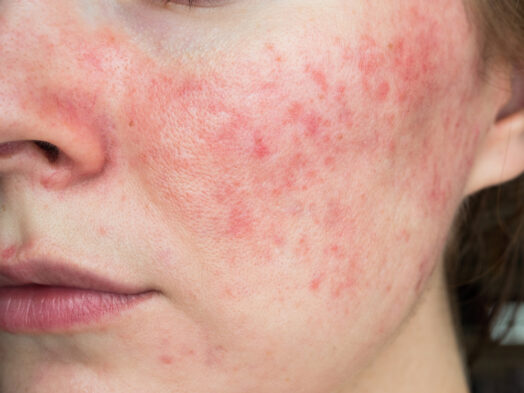
From what causes rosacea to how to get rid of the redness, bumps and irritation – here’s everything you need to know about the condition
JUMP TO SECTION
Click the links below to jump to the relevant section:
Many of us experience redness from time to time, whether it’s from too much sun, through blushing or when our skin isn’t particularly happy.
However, the occasional redness is different from rosacea which is a chronic skin condition that affects millions of people around the world.
Yes, it’s characterised by redness, but it can also be characterised by visible blood vessels, acne-like bumps, or what’s known as “rosacea nose.”
While the exact cause of rosacea is unclear, in this guide we explain the various aspects of rosacea, including its causes, symptoms, and treatments.
FURTHER READING: 8 reasons why your rosacea keeps flaring up – and what to do about your triggers
 Shutterstock
Shutterstock Rosacea is a chronic skin condition that causes persistent facial redness – with the key word being persistent. People with rosacea have redness most or all of the time and it usually affects the centre of the face across the cheeks, nose, forehead and chin.
One of the more severe types of rosacea is rhinophyma, also known as rosacea nose. This is an extreme type of rosacea that causes the skin around the nose to become thick and look bulbous and swollen.
Rosacea can also affect the eyes, a condition known as ocular rosacea. This type causes redness, dryness, and irritation of the eyes and eyelids, potentially leading to more serious eye issues if you don’t get it diagnosed or treated.
 Shutterstock
Shutterstock Rosacea can make your face look sunburned, or as if you’ve just been doing an intense workout. It causes your cheeks to flush a deep red, almost like slapped cheek disease in children, and can make your nose look red too.
It’s usually distinct from the type of redness caused by irritation on sensitive skin, although depending on the irritation and how long it lasts it can be difficult to tell the difference.
In addition to redness, you might also notice:
 Shutterstock
Shutterstock The exact cause of rosacea is unclear, but research suggests it’s caused by a combination of genetic, immune, environmental, lifestyle, and microbial factors that each contribute to its development and prevent it from going away.
These include:
FURTHER READING: 8 reasons why your rosacea keeps flaring up – and what to do about your triggers
 Shutterstock
Shutterstock While rosacea itself doesn’t typically feel itchy, it can create other sensations if the flare-ups are particularly bad. These often include burning, stinging, or a feeling of tightness.
The burning or stinging can sometimes come from the inflammation and dilation of blood vessels in the skin. This can lead to increased sensitivity and a feeling of warmth or irritation, especially when exposed to spicy foods, hot drinks, alcohol, and environmental factors like wind or the sun.
Some people with rosacea may experience itching if their skin becomes dry, but it’s less to do with the rosacea itself. When the skin barrier is compromised, it can lead to itching, flaking, and irritation. To manage dry skin, look for gentle, hydrating skincare specifically formulated for sensitive skin.
Rosacea can also sometimes coexist with other skin conditions that cause itching, like eczema or seborrheic dermatitis. Again, it’s not the rosacea causing the itching. It’s these overlapping conditions that can make it feel like it’s the rosacea causing the itchy skin. Having multiple skin conditions can also make it difficult to diagnose and treat rosacea, making it essential to speak to a dermatologist.
Due to the fact we don’t exactly what causes rosacea, it can be difficult to treat it effectively. It can take a bit of experimentation to work out what helps, and what doesn’t. In summary though, there are a couple of routes you can take.
 Shutterstock
Shutterstock Topical treatments are often the first line of defense against rosacea. These medications are applied directly to the skin to help with inflammation, redness, and bumps. Any cream for sensitive skin can help repair your skin barrier, but if you want something more targeted look for the following ingredients:
Oral medications can be prescribed for more severe cases of rosacea or when topical treatments don’t work.
 CellReturn
CellReturn These therapies are effective in targeting and reducing visible blood vessels as well as the persistent redness that comes with rosacea.
 mamabella | mamabella
mamabella | mamabella A gentle and consistent skincare routine is essential for managing rosacea. Harsh products can make the symptoms worse, so it is crucial to look for products designed for sensitive skin.
FURTHER READING: Best rosacea moisturiser UK | Azelaic acid: Everything you need to know about the acne, rosacea and hyperpigmentation saviour
Identifying and avoiding triggers is an annoying, but necessary part of managing rosacea.
While there is no definitive cure for rosacea, meaning it’s hard to get rid of rosacea permanently, you can significantly control and reduce its symptoms to balance the skin in the long-term. The main and best way to do this is through consistency – consistent use of treatments, consistently avoiding known triggers, being consistent with your skincare and consistently managing stress.
Consulting with a dermatologist or your GP can help get you on the best route to treatment quickly, and they can give you personalised treatment options and strategies.

Victoria is founder and editor-in-chief of mamabella, freelance journalist and Mum. She has a passion for empowering people to feel beautiful whatever their age, size, skin type and budget

